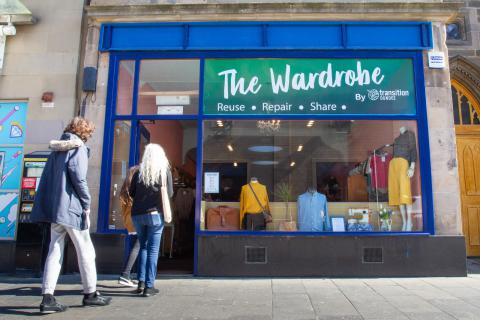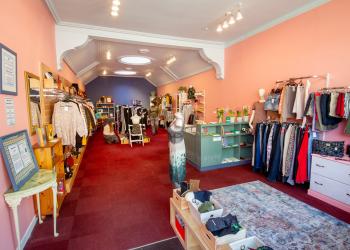The Wardrobe (by Transition Dundee CIC) aims to tackle clothing and textile waste, while reducing the stigma around second-hand clothing. Our new community space sells second-hand clothes to raise funds for our projects, whilst also running workshops and events that promote fabric crafts, repairing clothes and all things climate change. We also have a free section – this allows us to help those on a low income, as well as preventing even more fabric from potentially ending up in landfill! The Wardrobe is open Tuesday-Saturday, 11am-5pm (and until 7pm on Thursdays), with various events happening, also outside of those hours.

Transition Dundee CIC
Go To WebsiteAddressed Challenges:
- Health & wellbeing
- Carbon emissions
- Greater fairness/ Just transition
- Waste/Circular economy
- Excessive consumption
Action Areas:
- Circular Economy
- Finance
Initiative Purpose:
Mitigation & Adaptation
The Story

The story of The Wardrobe started back in 2017 when we started a ‘Give Box’ scheme across the city. We encouraged our community to donate items they no longer needed (not just clothes, but toys, books and other household items!) and we gave this to over 20 different charities helping people in need all over the city, such as Togs for Tots, The Methodist Clothing Project and Dundee Starter Packs. It became clear that clothing, and particularly women’s and children’s clothes (surprise!) were one of the most common things being thrown out. Whilst many people donate things they no longer need or want, charity shops and these projects were often inundated with much more than they can possible sell or give away. These excess clothes often end up being sold on and shipped to developing countries where they cause serious environmental and social problems. The scale of the problem was so huge we decided to try and tackle to the root of the problem, fast fashion and over-buying.
In 2017 we ran our first clothes swap aimed at the festive season, and encouraged people to donate and swap Christmas party outfits, to save buying something new. This was hugely popular and we soon started running a monthly event with men’s, women’s and children’s clothes too. During this event, we had volunteers in to run a ‘repair café’ where people could bring in items that needed a little love, and learned how to repair their items.
When COVID-19 happened and we could no longer run the big monthly events, we decided to set up a more permanent version that was open once a week – and this was called The Community Wardrobe (inspired by our Community Fridge project). All clothes were free as we were very well funded – and we found a huge demand from people on low incomes who didn’t have easy access to affordable clothes. When our funding was coming to an end we decided to turn this into an even more permanent shop where we could also generate some income to help continue our projects – and to ensure we were filling that demand. This is why it was important to us to maintain some access to free clothes for those who really need. There are far too many clothes already out there, so there is absolutely no need for people to do without – we just had to find the balance with raising enough funds for the project.
We opened the new version of the project in April 2022 and so far are off to a flying start – we aimed to make it a ‘charity shop with a difference’ – and are regularly told it’s not like a normal charity shop… exactly as we intended! While the main theme is stopping fast fashion, it is also about showing people what impact this has on climate change and introducing people to other ways to reduce their carbon footprints. We can’t do much as individuals to halt climate change – but as a community we can do so much!
Success & Outcomes
Because we piloted The Wardrobe in a previous version known as The Community Wardrobe, we knew the demand was there. We often had people telling us that charity shops were too expensive and not a nice experience being too crammed with clothes and so on. We consulted with our community in the set up of The Wardrobe to make sure they could help design it, inform how it was run and what kind of events, skill-sharing and workshops they would like to see us run. Feedback has been great so far and we have lots of ideas to help make this much more of a community space!
To help measure our impact in terms of clothing waste, we record how much clothing we save from potentially going to waste (in Kg’s), how many free items we are giving away so we have an idea of how those in need are being helped, how many people attend workshops, events and social groups and if they intend to change their buying habits as a result.
We still have a lot of work to do on changing attitudes towards second-hand clothes… while younger generations (and older ones at the other end of the scale!) are more into thrifting, there is a generation in the middle who are less likely to buy second-hand and we want to help change that by showing people how shopping at a ‘cool’ little shop like ours can help the environment, people on low incomes and much, much more.
Advice for others looking to do something similar
Because we were previously funded by the Scottish Government’s Climate Challenge Fund, we were part of an amazing network of projects all over Scotland – an endless supply of inspiration, ideas and experience. We are now part of the even larger Transition Network – a great source of information and inspiring projects that we recommend researching if you are looking to do something similar! Learning from other projects, what has worked and what hasn’t, has been the biggest help to us. Zero Waste Scotland also has a lot of great resources and help, it’s well worth reaching out to them.
We know from the volume of clothes we receive that there is a lot going around – we realty think there’s space for projects like ours in all communities. Have a look at what local projects you have and reach out to them whether it’s a local environmental group or a clothes bank, they may have ideas for what is needed, what works etc.
One of the biggest challenges for us has been raising enough to cover all the costs we need to cover to keep all of our projects going. Setting up as a social enterprise has helped us to think about funding in a new way and to try and generate income in new and innovative ways, that also benefit our community. There are lots of funding pots out there for environmental/social issues just now – a lot of funders also have great resources to help you get started and how to maintain your projects.
There are a lot of people out there interested in climate change and the related issues, do a community consultation and find out what the needs and wants are. People may even be willing to share some of their time and skills to help you!


